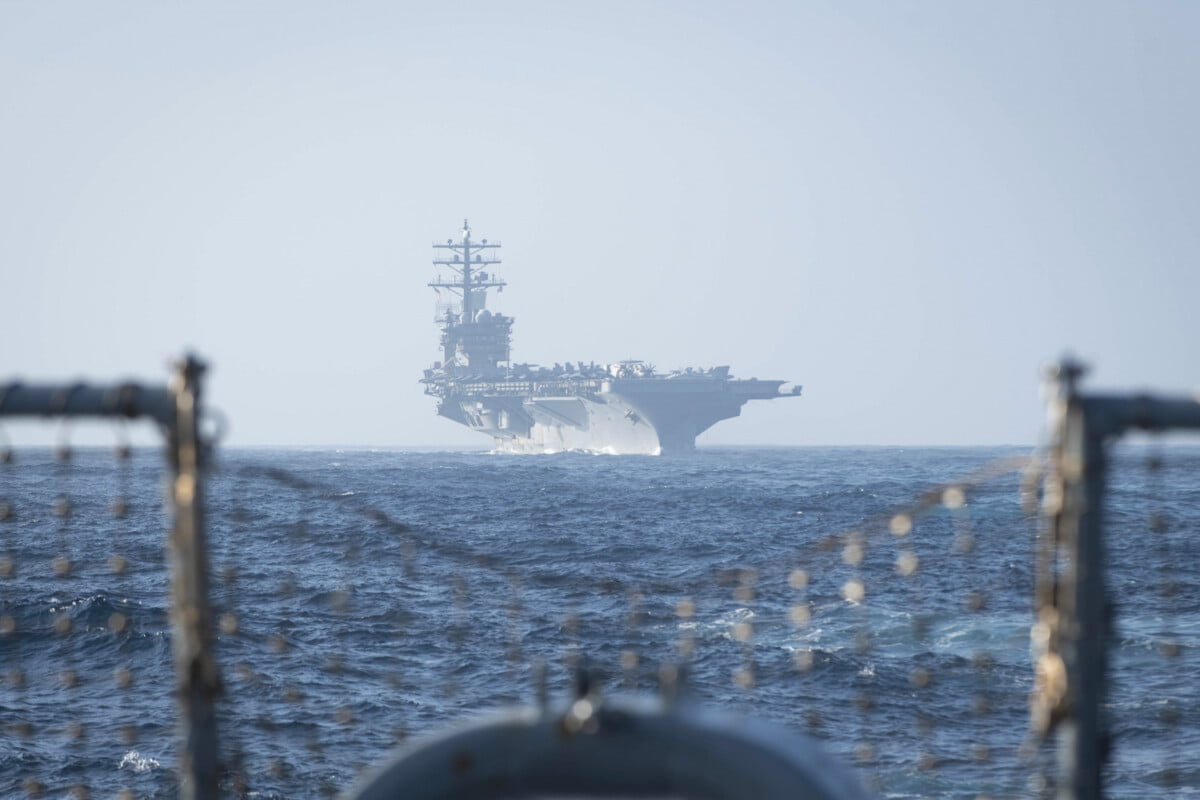The USS Dwight D. Eisenhower Carrier Strike Group (IKE CSG) is participating in Operation Lightning Handshake, a bi-lateral maritime exercise between the U.S. and the Royal Moroccan Navy (RMN) and Royal Moroccan Air Force (RMAF) during the first week of March, which will take place between The Canary Islands coastal waters and Morocco’s Port of Agadir.
“It’s an honour to participate in this historic bi-lateral maritime exercise; hallmarking 200 years of an enduring partnership with Morocco.” – Rear Adm. Robertson
The exercise enhances interoperability between the U.S. and Moroccan Navies across multiple warfare areas, many of which include: surface warfare, anti-submarine warfare, air and strike warfare, combined logistics support, maritime interdiction operations.
 “On behalf of the Sailors assigned to the IKE CSG it’s an honor to participate in this historic bi-lateral maritime exercise; hallmarking 200 years of an enduring partnership with Morocco,” said Rear Adm. Scott Robertson, commander, Carrier Strike Group Two. “Exercises like Lighting Handshake enhance the foundation of our interoperability and continued support of our long term commitment to security in the region.”
“On behalf of the Sailors assigned to the IKE CSG it’s an honor to participate in this historic bi-lateral maritime exercise; hallmarking 200 years of an enduring partnership with Morocco,” said Rear Adm. Scott Robertson, commander, Carrier Strike Group Two. “Exercises like Lighting Handshake enhance the foundation of our interoperability and continued support of our long term commitment to security in the region.”
Lightning Handshake 2021 increases the ability of U.S. and Moroccan maritime forces to work together in order to address security concerns and increase stability in the region.
Participating ships in Lightning Handshake from the IKE CSG, commanded by Rear Adm. Scott Robertson, include flagship USS Dwight D. Eisenhower (CVN 69); and Destroyer Squadron 22 ships include Arleigh Burke-class guided-missile destroyers USS Mitscher (DDG 57), and USS Porter (DDG 78).
Aircraft participating in Lightning Handshake include – Squadrons of Carrier Air Wing (CVW) 3, embarked on Eisenhower include the “Fighting Swordsmen” of Strike Fighter Squadron (VFA) 32, “Gunslingers” of Strike Fighter Squadron (VFA) 105, “Wildcats” of Strike Fighter Squadron (VFA) 131, “Rampagers” of Strike Fighter Squadron (VFA) 83; “Dusty Dogs” of Helicopter Sea Combat Squadron (HSC) 7; “Swamp Foxes” of Helicopter Maritime Strike Squadron (HSM) 74; “Screwtops” of Airborne Command and Control Squadron (VAW) 123; “Zappers” of Electronic Attack Squadron (VAQ) 130, and a detachment from Fleet Logistics Support Squadron (VRC) 40 “Rawhides.”
Moroccan assets participating in Lightning Handshake include: Royal Moroccan Navy Frigate Tarnk Ben Ziyad (SIGMA Class Frigate) Royal Naval HQ Maritime Operations Center (MOC) Royal Air Force HQ Air Operations Center (AOC), one Panther Helicopter, and two of each fixed-wing combat F-16 and F-5 fighter aircraft.
 USS Harry S. Truman Carrier Strike Group (HSTCSG) participated in the 2018 exercise and included unit events which flexed interoperability between the U.S. and Royal Moroccan Navies in the following warfare areas; communication, link, Anti-Submarine Warfare, close air support and Naval Surface Fire Support.
USS Harry S. Truman Carrier Strike Group (HSTCSG) participated in the 2018 exercise and included unit events which flexed interoperability between the U.S. and Royal Moroccan Navies in the following warfare areas; communication, link, Anti-Submarine Warfare, close air support and Naval Surface Fire Support.
Dwight D. Eisenhower Carrier Strike Group is a multiplatform team of ships, aircraft and more than 5,000 Sailors, capable of carrying out a wide variety of missions around the globe.
U.S. Sixth Fleet, headquartered in Naples, Italy, conducts the full spectrum of joint and naval operations, often in concert with allied and interagency partners, in order to advance U.S. national interests and security and stability in Europe and Africa.
“Operating from bases at Casablanca, Safi, Agadir, Kenitra, and Tangier, the navy has acquired new equipment designed to expand its operational capabilities. The Moroccan Navy has become a growing and important partner with the U.S. Navy in Europe and Africa and has been a major participant in the U.S. Navy led annual multi-country exercise Phoenix Express, as well as a joint maritime law enforcement operation held in July 2009.
The navy’s responsibilities for coastal protection were significantly broadened in 1973 when Morocco increased the limits of its territorial waters to 70 nautical miles. Further pressures were put upon the service in 1981, when the government adopted an Exclusive Economic Zone and restricted the ability of foreign fishing fleets to operate within 200 nautical miles of Morocco. Since that time the navy has been kept busy patrolling Moroccan waters, and there were numerous reports of Spanish, Portuguese, Soviet, and South Korean trawlers being detained and taken to Moroccan ports for having violated the country’s restrictions on foreign fishing. The navy also has assisted in attempts to stem traffic in contraband and drugs that has moved through Moroccan ports.
On 3 January 1976, the Moroccan Navy stopped a Soviet cargo ship off the Spanish Sahara and found a cargo of arms. In response to the evidence of increased Soviet support for the Polisario rebels, U.S. Navy vessels made three port visits in Morocco during January 1976. The US Secretary of State, with the concurrence of the Department of Defense, decided that a well-publicised U.S. Naval visit to Agadir would be desirable to send a signal to the Soviets in response to the positioning of three Soviet Navy ships in the region. A three-day visit by CG-20 Turner early in February followed.”
Today the Kingdom of Morocco is a key strategic partner in Africom, the US Military Africa Command and increasingly one of Africa’s largest purchasers of US arms, rivalling Algeria and Saudi Arabia in arms bought over recent years. The Polisario Front, fighting for the liberation of Western Sahara, declared a resumption of hostilities with Morocco last November following ever more heavy handed tactics deployed against protesters demonstrating Morocco’s continued occupation, resource stripping and illegal road building in the disputed territory, ending a 29-year ceasefire.













